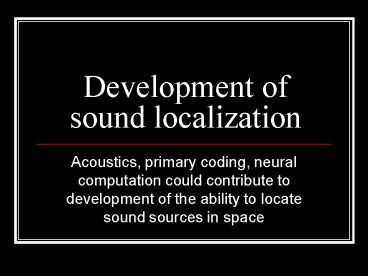Development of sound localization - PowerPoint PPT Presentation
1 / 37
Title:
Development of sound localization
Description:
Rattle, rattle... Rattle, rattle... Rattle, rattle... Rattle, rattle... Rattle, rattle... Rattle, rattle... – PowerPoint PPT presentation
Number of Views:135
Avg rating:3.0/5.0
Title: Development of sound localization
1
Development of sound localization
- Acoustics, primary coding, neural computation
could contribute to development of the ability to
locate sound sources in space
2
Topics in development of sound localization
- When can infants first locate sounds?
- How accurate is localization during development?
- How could the development of binaural cue
processing contribute? - Other distance perception and precedence effect
3
Left-right discriminations
4
Left-right discrimination Kittens
meow
5
Left-right discrimination Rats
6
Left-right discrimination Frequency effects
7
Left-right discrimination Human infants
8
Accuracy of localization during development
Minimum Audible Angle
Sound
Sound
Speakers
MAA
Sound
9
MAA measured in several studies
10
Changes in head size with age
11
Acoustic consequences of a small head
400 µsec ITD
12
IID and ITD discrimination Infants
13
ITD discrimination Infants
14
IID and ITD discrimination Children
15
Localization in elevation depends on spectral cues
16
Localization in elevation Infants
shh, shh, shh
16º
shh, shh
0º
17
MAA in elevation Infants
18
Sound localization involves three dimensions
elevation
azimuth
distance
19
Distance perception Infants
Rattle, rattle
Rattle, rattle
Rattle, rattle
Rattle, rattle
Rattle, rattle
Rattle, rattle
20
Distance perception Infants
21
Precedence effect
?
click
click
22
Precedence effect Infants
23
Precedence effect Children
24
Summary
- Young animals can localize at least grossly, soon
after the cochlea starts to function. - Human newborns can also localize sounds, but the
MAA improves from birth to 5 years of age. - Infants can localize sounds in all three spatial
dimensions. - Acoustics and interaural cue processing cannot
fully account for the maturation of sound
localization. - Localization under simple conditions may be
mature at 5 years of age, but under complex
conditions, 5 year-olds are still immature sound
localizers.
25
Effects of experience on sound localization
26
Pairing of visual and auditory information leads
to organization of sensory space.
27
Effects of experience on localization by barn owls
28
Critical period for spatial recalibration
29
The critical period for re-adjusting after
unplugging is different!
30
The more the owl uses his map, the longer it
remains plastic
31
Effects of experience in humans Wilmington, Gray
and Jahrsdorfer (1994)
- 19 subjects with congenital unilateral atresia
- Tested before and after corrective surgery
- Age at surgery ranged from 6 to 33 years.
- Tests included ITD and IID discrimination, speech
in noise (sound field), and sound localization.
32
Interaural time discrimination after correction
of unilateral atresia
33
Localization after correction of unilateral
atresia
34
Chicks in auditory space
35
Chicks maps of auditory space
36
Speech in noise identification after correction
of unilateral atresia
37
Summary of effects of experience on sound
localization
- Experience with sound is essential for the
development of sound localization. - Experience with sound is less essential for the
development of the ability to process the
acoustic cues to location. - Although a critical period for the development of
localization has been identified in some other
species, a similar critical period has not yet
been identified in humans.































